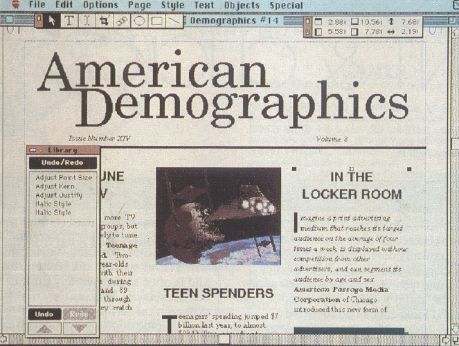
YOU DON'T HAVE TO SPEND A LOT OF MONEY FOR A POWERFUL DESKTOP PUBLISHING PROGRAM—YOU CAN
PUBLISH FOR PENNIES
GREGG KEIZER
First desktop publishing hit the Macintosh, then it hit the pocketbook. Expensive software, big-screen monitors, vast RAM—all became essential to desktop publishing faster than you could say Johannes Gutenberg. Spiraling features wars spawned even higher-priced and more overpowering page-layout programs; it wasn't long before desktop publishing became as complicated as the clanking Linotronic typesetters it was meant to replace.
For most of us, the high cost—in both money and time—is overkill, pure and simple. Desktop publishing (DTP) was supposed to put the power of the press in everyone's hands and make it possible for even the uninitiated to produce quality newsletters, reports, brochures, and forms. Where did the dream go wrong?
Two Macintosh software publishers believe that the dream of inexpensive, easy-to-do page design is still alive and that there are thousands of Macintosh owners who don't need PageMaker or QuarkXPress to churn out personal and business publications. You know what? They're right.
Gunfight at the DTP Corral
Two Macintosh packages promise quick-start DTP. Springboard Publisher II from Springboard and Publish It! Easy from Timeworks have staked claim to the same territory: first-time desktop publishers who want an affordable, easy-to-learn, and simple-to-use program.
The two programs share much, including their price and frame-based approach to layout. But they aren't twins. Springboard Publisher behaves as much like a graphics program as a desktop publishing package, while Publish It! Easy emphasizes its precise layout process and word processing power. Each appeals to a different audience. Springboard Publisher seems most appropriate for those who want to dabble in a free-form DTP environment, such as teachers, home office workers with the occasional publishing job, and professionals with light newsletter responsibilities. Publish It! Easy, however, is more structured and concise and so wins the nod from desktop publishers with lengthier, more frequent publication tasks.
To see just how well these two programs perform, I applied the classic user's test: I pulled both programs out of the box, put them on a one-megabyte, 68000-equipped Macintosh, and created a one-page newsletter from scratch with as little documentation time as possible. I looked for each program's strengths and weaknesses, each package's best applications, and the most appropriate users.
It's a Natural
For a low-cost, low-end desktop publishing alternative, try Springboard Publisher. Publisher excels at quick, free-form design and is better suited for layout novices than Publish It! Easy. The interface and operation is simpler, cleaner, and depends less on prior desktop publishing knowledge. Rather than select a tool to place a frame as you do in Publish It! Easy, for instance, here you simply click and drag the mouse.
Start to finish, I put together my one-page newsletter in about an hour, including some time spent poring over the manual for the inevitable how-to details. I created a five-column format (up to nine are possible for really flexible designs) and then quickly set up frames (you see these onscreen as boxes) to later fill with either text or graphics. Dropping in rules (thin horizontal or vertical lines) was easy, though one quirk stumped me: You've got to call up the Rules box before you can select or move an existing rule.

Springboard Publisher imports several word processor file formats directly, including some (but not all) of the Microsoft Word, Microsoft Works, WriteNow, and Mac Write versions. That's important, for you'll still need your word processor after you unwrap this package. Springboard Publisher's strengths are in its design and graphic arts abilities, not in its text processing. You'll welcome the Typing Window, where you can enter copy faster than on the page itself, but it's no substitute for a good word processor.
A major portion of Springboard Publisher's power lies in its graphics features. There's a paint program inside Publisher itching to get out. Publisher works great at creating original work or correcting imported graphics once they're in place. This is one of the reasons why Springboard Publisher outdoes Publish It! Easy in producing quick flyers and graphics-heavy newsletters. An outstanding feature is this program's impressive handling of text as it wraps around graphics. It's the best and most flexible I've seen.
Publisher includes only 15 sample layouts, a less-than-adequate number for desktop beginners. The short-coming is corrected to an extent by a free offer of 36 newsletter templates (you pay a $5 shipping-and-handling fee for the collection).
Many of you won't miss the sample layouts, if only because Springboard Publisher is a natural. You can step up to Springboard Publisher without knowing more about DTP than what the acronym stands for and still assemble a design. That's a tribute to its easy-going approach. The program just feels looser, as if it were less a desktop publishing program than a collection of tools you use to combine graphics and words on the page. Little is hidden or inaccessible, and everything from changing margins to setting up columns is available and fairly intuitive.
Springboard Publisher is your pick if you're tackling elementary publishing assignments with bitmapped graphics—simple letterheads, announcements, school reports, one-page flyers, and low-end newsletters—or if you expect to handle desktop publishing chores infrequently.
The Big Easy
Publish It! Easy brings a more traditional outlook to low-cost desktop publishing. That's understandable, for it's a scaled-down version of Publish It!, a high-powered program for serious desktop publishers. Publish It! Easy looks, feels, and acts more like a typical desktop publishing program than does Springboard Publisher. It's a bit hard to handle at first, but it makes up for that trouble in finer control over your publication.
My one-page newsletter took nearly two hours to assemble with Publish It! Easy, primarily because several steps in the design process are not intuitive. Rather than provide for document-wide margins, for instance, Publish It! Easy assumes you'll discover that you set left and right margins within the frames themselves.

The built-in word processor is almost up to the task; you may be tempted to use it to write more than headlines and captions. You'll welcome its powerful tab features and its built-in thesaurus if you do use Easy's writing tools. I recommend that you rely on your word processor, though. That's not hard, since Easy imports the same word processor formats as Springboard Publisher, plus WordPerfect.
Publish It! Easy may be a bit less capable of handling bitmapped graphics than Springboard Publisher, but its text frame handling is superior, especially when it comes to controlling the placement and alignment of the frames on a page. What was a guessing game in Springboard Publisher (are those two frames really lined up?) is an exact science in Easy. You simply select any number of frames and align them by any edge. And Easy uses a snap-to alignment grid that automatically attracts frames to doubly ensure accurate placement.
Your working screen can get cluttered in Publish It! Easy, for several free-floating palettes put the most-often-used tools at your fingertips. On a small-screen Macintosh, there's a danger of loosing the work under the palettes. These tool palettes do speed things up, though, especially when you're experimenting with different type characteristics, and you can always make them disappear to let you see the entire screen.
Once you've put the time into designing a publication or page, you can quickly pour imported text into linked frames. And you can store your designs as templates for future use; that way you can call up one any time and simply flow text into the frames. Though Publish It! Easy is tough for the first-time user, it softens the blow by giving you over 70 ready-to-use designs. Ranging from newsletters to brochures to letterheads, many of the designs are topnotch (I used one of the designs as a model for my made-from-scratch newsletter).
Publish It! Easy makes you work harder than does Springboard Publisher. Its terminology assumes you know something about desktop publishing (words like baseline and leading appear in its menus), and some of its features are quite advanced (built-in rotated text, automatic kerning, and spot color, for instance). The payoff is a program that's ready for the long haul. If you're publishing regular, structured documents such as professional-quality newsletters or catalogs, Publish It! Easy should be your choice. Less home-oriented than Springboard Publisher, Publish It! Easy is a good pick for small business, consulting, professional, and home office workers striving for a superior publication image.
The Envelope, Please
These two programs provide more than enough DTP tools to complete nearly every home, home office, small business, and classroom publishing task I can think of. In fact, unless you're a DTP professional, you shouldn't outgrow either package.
It's a close call, but Publish It! Easy is my choice. You may take more time to learn it, but the time will be well spent. It's simply a stronger, more focused program that pays more attention to the necessities of page design and less to graphics effects. Its frame alignment and custom underlying grid help create exactly the design you're after, while the tear-off palettes let you quickly make changes or call up features.
No matter which you choose, both Springboard Publisher and Publish It! Easy give you desktop publishing power at a price you can't beat. Both fulfill the promise of do-it-yourself publishing for pennies.